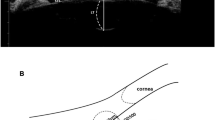Abstract
Background
Evaluation of anterior chamber depth (ACD) can potentially identify those patients at risk of angle-closure glaucoma. We aimed to: compare van Herick’s limbal chamber depth (LCDvh) grades with LCDorb grades calculated from the Orbscan anterior chamber angle values; determine Smith’s technique ACD and compare to Orbscan ACD; and calculate a constant for Smith’s technique using Orbscan ACD.
Methods
Eighty participants free from eye disease underwent LCDvh grading, Smith’s technique ACD, and Orbscan anterior chamber angle and ACD measurement.
Results
LCDvh overestimated grades by a mean of 0.25 (coefficient of repeatability [CR] 1.59) compared to LCDorb. Smith’s technique (constant 1.40 and 1.31) overestimated ACD by a mean of 0.33 mm (CR 0.82) and 0.12 mm (CR 0.79) respectively, compared to Orbscan. Using linear regression, we determined a constant of 1.22 for Smith’s slit-length method.
Conclusions
Smith’s technique (constant 1.31) provided an ACD that is closer to that found with Orbscan compared to a constant of 1.40 or LCDvh. Our findings also suggest that Smith’s technique would produce values closer to that obtained with Orbscan by using a constant of 1.22.



Similar content being viewed by others
References
Lowe RF (1968) Time-amplitude ultrasonography for ocular biometry. Am J Ophthalmol 66:913–918
Congdon NG, Youlin Q, Quigley H, Hung PT, Wang TH, Ho TC, Tielsch JM (1997) Biometry and primary angle-closure glaucoma among Chinese, white, and black populations. Ophthalmology 104:1489–1495
Barrett BT, McGraw PV, Murray LA, Murgatroyd P (1996) Anterior chamber depth measurement in clinical practice. Optom Vis Sci 73:482–486
Smith RJH (1979) A new method of estimating the depth of the anterior chamber. Br J Ophthalmol 63:215–220
Wishart PK, Batterbury M (1992) Ocular hypertension: correlation of anterior chamber angle width and risk of progression to glaucoma. Eye 6:248–256
Van Herick W, Shaffer RN, Schwartz A (1969) Estimation of width of angle of anterior chamber. Incidence and significance of the narrow angle. Am J Ophthalmol 68:626–629
Rabsilber TM, Khoramnia R, Auffarth GU (2006) Anterior chamber measurements using Pentacam rotating Scheimpflug camera. J Cataract Refract Surg 32:456–459
Alsbirk PH (1986) Limbal and axial chamber depth variations. A population study in Eskimos. Acta Ophthalmol (Copenh) 64:593–600
Thomas R, George T, Braganza A, Muliyil J (1996) The flashlight test and van Herick’s test are poor predictors for occludable angles. Aust N Z J Ophthalmol 24:251–256
Foster PJ, Devereux JG, Alsbirk PH, Lee PS, Uranchimeg D, Machin D, Johnson GJ, Baasanhu J (2000) Detection of gonioscopically occludable angles and primary angle-closure glaucoma by estimation of limbal chamber depth in Asians: modified grading scheme. Br J Ophthalmol 84:186–192
Douthwaite WA, Spence D (1986) Slit-lamp measurement of the anterior chamber depth. Br J Ophthalmol 70:205–208
Boscia F, La Tegola MG, Alessio G, Sborgia C (2002) Accuracy of Orbscan optical pachymetry in corneas with haze. J Cataract Refract Surg 28:253–258
Lackner B, Schmidinger G, Pieh S, Funovics MA, Skorpik C (2005) Repeatability and reproducibility of central corneal thickness measurement with Pentacam, Orbscan, and ultrasound. Optom Vis Sci 82:892–899
Auffarth GU, Tetz MR, Biazid Y, Völcker HE (1997) Measuring anterior chamber depth with Orbscan topography system. J Cataract Refract Surg 23:1351–1355
Koranyi G, Lydahl E, Norrby S, Taube M (2002) Anterior chamber depth measurement: a-scan versus optical methods. J Cataract Refract Surg 28:243–247
Reddy AR, Pande MV, Finn P, El-Gogary H (2004) Comparative estimation of anterior chamber depth by ultrasonography, Orbscan IIz II, and IOLMaster. J Cataract Refract Surg 30:1268–1271
Hashemi H, Yazdani K, Mehravaran S, Fotouhi A (2005) Anterior chamber depth measurement with a-scan ultrasonography, Orbscan II, and IOLMaster. Optom Vis Sci 82:900–904
Utine CA, Altin F, Cakir H, Perente I (2009) Comparison of anterior chamber depth measurements taken with the Pentacam, Orbscan IIz and IOLMaster in myopic and emmetropic eyes. Acta Ophthalmol 87:386–391
Rabsilber TM, Becker KA, Frisch IB, Auffarth GU (2003) Anterior chamber depth in relation to refractive status measured with the Orbscan II Topography System. J Cataract Refract Surg 29:2115–2121
Rabsilber TM, Becker KA, Auffarth GU (2005) Reliability of Orbscan II topography measurements in relation to refractive status. J Cataract Refract Surg 31:1607–1613
Osuobeni EP, Oduwaiye KA, Ogbuehi KC (2000) Intra-observer repeatability and inter-observer agreement of the Smith method of measuring the anterior chamber depth. Ophthalmic Physiol Opt 20:153–159
Allouch C, Touzeau O, Borderie V, Puech M, Ameline B, Scheer S, Laroche L (2002) Orbscan IIz: a new device for iridocorneal angle measurement. J Fr Ophtalmol 25:799–806
Bland JM, Altman DG (1986) Statistical methods for assessing agreement between two methods of clinical measurement. Lancet 1:307–310
Fisch BM (1993) Gonisocopy and the glaucomas. Butterworth-Heinemann, Stoneham
Kashiwagi K, Tokunaga T, Iwase A, Yamamoto T, Tsukahara S (2005) Agreement between peripheral anterior chamber depth evaluation using the van Herick technique and angle width evaluation using the Shaffer system in Japanese. Jpn J Ophthalmol 49:134–136
Author information
Authors and Affiliations
Corresponding author
Rights and permissions
About this article
Cite this article
Eperjesi, F., Holden, C. Comparison of techniques for measuring anterior chamber depth: Orbscan imaging, Smith’s technique, and van Herick’s method. Graefes Arch Clin Exp Ophthalmol 249, 449–454 (2011). https://doi.org/10.1007/s00417-010-1500-0
Received:
Revised:
Accepted:
Published:
Issue Date:
DOI: https://doi.org/10.1007/s00417-010-1500-0




